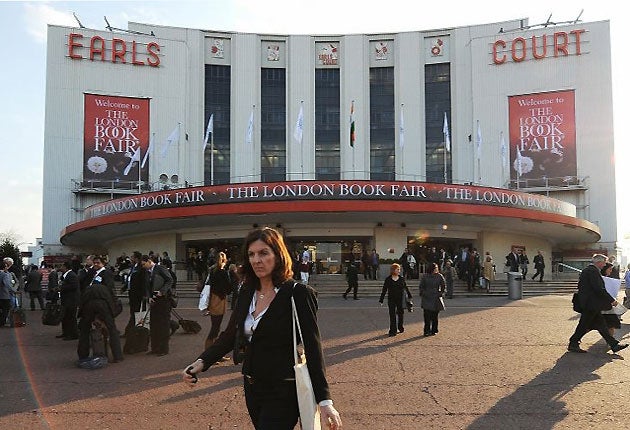Olympic volleyball will be Earls Court swansong

Your support helps us to tell the story
From reproductive rights to climate change to Big Tech, The Independent is on the ground when the story is developing. Whether it's investigating the financials of Elon Musk's pro-Trump PAC or producing our latest documentary, 'The A Word', which shines a light on the American women fighting for reproductive rights, we know how important it is to parse out the facts from the messaging.
At such a critical moment in US history, we need reporters on the ground. Your donation allows us to keep sending journalists to speak to both sides of the story.
The Independent is trusted by Americans across the entire political spectrum. And unlike many other quality news outlets, we choose not to lock Americans out of our reporting and analysis with paywalls. We believe quality journalism should be available to everyone, paid for by those who can afford it.
Your support makes all the difference.For more than 70 years its striking art deco entrance has towered over the surrounding area. Millions of people have traipsed through its doors on their way to events as varied as beer festivals and the Brit Awards. But once the 2012 Olympics is over, London’s Earls Court exhibition centre will be flattened.
A huge redevelopment will create one of the most lucrative property opportunities in the centre of the capital for decades – but it will also almost certainly lead to the demolition of a venue which has made Earls Court famous throughout the world. No changes can be made until after the Olympics because Earls Court has been chosen to host the volleyball tournament.
If the exhibition centre is pulled down it would close the chapter on one of the capital’s most famous entertainment venues. The area began to be used for exhibitions in the late 19th century when Wild West legend “Buffalo Bill” introduced the British public to hundreds of real cowboys and indigenous Americans for a show which pulled in daily crowds of 15,000. In the First World War the area became a refugee camp for Belgians before being abandoned.
The Earls Court we know today, with its landmark white entrance, opened its doors to the public in 1937 with a “Chocolate and Confectionery Exhibition” and went on to become a key music venue. In the mid 1970s, Pink Floyd and Led Zeppelin played what many fans believe were the finest gigs of their careers at Earls Court and in recent years the venue has been known for hosting the Brit Awards.
But, according to Event Magazine, it has come under pressure from rivals such as the O2 Arena and the Excel Centre. The property investment firm Capital and Counties (Capco) has acquired full ownership of the west London venue and intends to submit a planning application which would see a 70-acre area around the conference centre turned into a mainly residential site.
The deal also netted Capco the Olympia venue in nearby Kensington, which, unlike Earls Court, will be kept as an exhibition centre and redeveloped. If the exhibition centre is pulled down it would close the chapter on one of the capital’s most well-known entertainment venues. In recent years, it has had to compete with rivals the O2 Arena and the Excel Centre.
Capco, which is a subsidiary of the FTSE 100 property giant Liberty International, already owned 50 percent of the Earls Court exhibition centre but last week it secured the final half after persuading a group, led by the entrepreneurs David Coffer and Anthony Lyons, to sell up.
Any redevelopment of the music venue would depend on support from Transport for London, which owns a train depot behind the exhibition centre, and Hammersmith and Fulham council, which wants to redevelop two large housing estates. The three have signed a “collaboration agreement” in which they agree, in principal, to work together to create a new housing development meaning there will likely be little opposition to the plans from within the Tory led local council.
Paul Colston, managing editor of Exhibition News, said: “This will strip UK exhibition organisers of a major venue resource in the capital, home to the Brits and national heritage events such as the Ideal Home Show. After the 2012 Olympics the capital’s exhibition flagship seems set to be no more, which is a London and national tragedy.”
Stephen Greenhalgh, the leader of Hammersmith and Fulham Council and a close friend of London Mayor Boris Johnson, said yesterday: “This is probably the most exciting development opportunity in London at the moment. We can redevelop housing estates and bring new jobs to the area.”
But others fear that the demolition of the exhibition centre would tear the heart out of the area. “If Earls Court went it would be a disaster,” said Labour councillor Stephen Cowan. “It employs a lot of local people and large numbers of traders rely on the exhibition centre to bring people from the outside into the area.”
Chris Rumfitt, a spokesperson for CapCo, said: “We’re still at an early stage, probably 12 months away from submitting a planning application, but in terms of exhibition provision we would be looking to enhance Olympia rather than replace exhibition usage at Earls Court. The current thinking is that facilities at Olympia could be enhanced and the Earls Court site will be turned into a mixed-use but residential-led site.”
Subscribe to Independent Premium to bookmark this article
Want to bookmark your favourite articles and stories to read or reference later? Start your Independent Premium subscription today.
Join our commenting forum
Join thought-provoking conversations, follow other Independent readers and see their replies
Comments